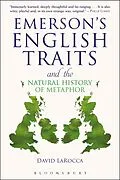Metaphors are ubiquitous and yet-or, for that very reason-go largely unseen. We are all variously susceptible to a blindness or blurry vision of metaphors; yet even when they are seen clearly, we are left to situate the ambiguities, conflations and contradictions they regularly present-logically, aesthetically and morally. David LaRocca's book serves as a set of 'reminders' of certain features of the natural history of our language-especially the tropes that permeate and define it. As part of his investigation, LaRocca turns to Ralph Waldo Emerson's only book on a single topic, English Traits (1856), which teems with genealogical and generative metaphors-blood, birth, plants, parents, family, names and race. In the first book-length study of English Traits in over half a century, LaRocca considers the presence of metaphors in Emerson's fertile text-a unique work in his expansive corpus, and one that is regularly overlooked. As metaphors are encountered in Emerson's book, and drawn from a long history of usage in work by others, a reader may realize (or remember) what is inherent and encoded in our language, but rarely seen: how metaphors circulate in speech and through texts to become the lifeblood of thought.
Autorentext
David LaRocca is the author, editor, or coeditor of more than a dozen books. He edited Movies with Stanley Cavell in Mind (Bloomsbury, 2021), Inheriting Stanley Cavell (Bloomsbury, 2020), a commemorative issue of Conversations: The Journal of Cavellian Studies (2019), and Stanley Cavell's Emerson's Transcendental Etudes (2003). He has taught philosophy and cinema and held visiting research or teaching positions in the United States at Binghamton University, Cornell University, Harvard University, Ithaca College, the School of Visual Arts, the State University of New York College at Cortland, and Vanderbilt University.
Inhalt
Prefatory Notes .......................................................................................................
Introduction: Some Traits of English Traits .....................................................
I. More Prone to Melancholy..............................................
II. With Muffins and Not the Promise of Muffins............
III. The Lively Traits of Criticism..........................................
IV. The Cabman is Phrenologist So Far ..............................
V. The Florilegium and the Cabinets of Natural History
VI. Founding Thoughts...........................................................
VII. A Child of the Saxon Race...............................................
VIII. Living Without a Cause.....................................................
IX. Adapting Some Secret of His Own Anatomy...............
X. First Blood..........................................................................
XI. Second Selves......................................................................
XII. Genealogy and Guilt...........................................................
XIII. The Pirate Baptized.............................................................
XIV. My Giant Goes With Me...................................................
XV. Corresponding Minds........................................................
XVI. Titles Manifold.....................................................................
Acknowledgements ....................................................................................................
Notes .........................................................................................................................
Index ..........................................................................................................................
